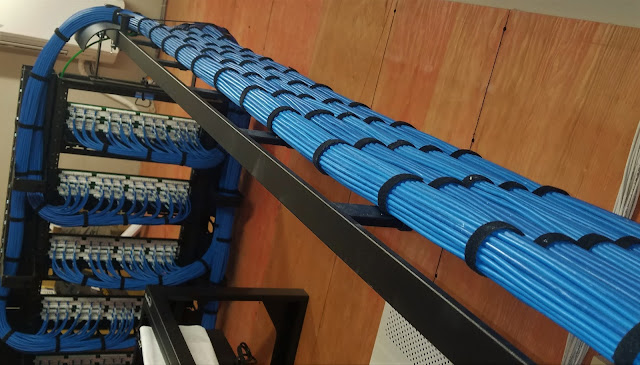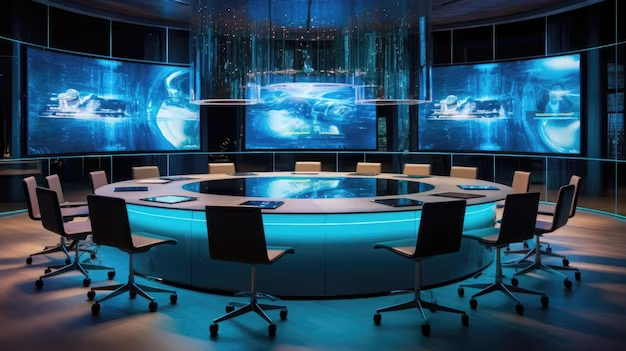The Future Soundscape in Audio Video Solutions for Business Conferencing
In the fast-paced world of business, effective communication lies at
the heart of success. Picture this: a critical board meeting with key
stakeholders, each located in different corners of the globe. The challenge?
Ensuring that the nuances of each conversation are captured accurately, the
sentiments conveyed seamlessly, and decisions made collectively. This scenario
encapsulates the modern challenges faced in business conferencing. Gone are the
days of traditional, solely audio-based interactions; today, businesses lean
heavily on the dynamic duo of audio video
solutions to bridge geographical gaps and facilitate collaborative
decision-making.
The Evolution of Business Conferencing
The journey of business conferencing has traversed a remarkable
evolution. Think back to the era of crackling audio calls where voices echoed
through landline phones, barely capturing the essence of the discussion. Fast
forward to the integration of audio and video technologies, where virtual
meetings have become immersive experiences. This evolution reflects not just
technological progress but a fundamental shift in how businesses prioritize
communication – from mere auditory exchanges to a holistic, visual and auditory
engagement.
Components of Audio Video Solutions
Audio Elements
In the realm of audio technology, monumental strides have been made.
Imagine a meeting where every spoken word is crystal clear, where background
noise is a distant memory. High-definition microphones have revolutionized the
audio landscape, ensuring that every participant's voice resonates with
precision. Noise-canceling features further enhance the clarity, eliminating
distractions and fostering an environment conducive to focused discussions.
Video Elements
The visual dimension of business conferencing has undergone a
transformative journey. With the advent of 4K cameras, meetings are no longer
restricted to pixelated, grainy visuals. Instead, participants are treated to
lifelike, high-resolution images that capture facial expressions, body
language, and presentation materials with stunning clarity. AI-driven video
enhancements elevate the experience, providing dynamic adjustments for optimal
lighting, background blurring, and even augmenting video quality in low-bandwidth
conditions.
This convergence of cutting-edge audio and video technologies paints a
vivid picture of the present-day business conferencing landscape, where
seamless communication is no longer an aspiration but a tangible reality.
Immersive Meeting Spaces
Virtual Reality (VR) Integration
Imagine stepping into a virtual boardroom where geographical distances
dissolve, and colleagues appear in life-sized avatars around a shared virtual
table. VR technologies are ushering in a new era of immersive meeting spaces,
where participants don VR headsets to enter a three-dimensional world that
simulates physical presence. This isn't just a meeting; it's an experience that
transcends the limitations of traditional virtual interactions, fostering
collaboration in a space where participants can almost shake hands.
Augmented Reality (AR) Applications
AR is the magician of the business conferencing realm, adding a layer
of enchantment to the visual elements. In practical terms, it overlays digital
information seamlessly onto the real-world backdrop during live interactions.
Consider a product presentation where 3D models materialize on the conference
table or dynamic data graphs hover in the air. AR transforms the mundane into
the extraordinary, making presentations more engaging and interactive, pushing
the boundaries of what's possible in a virtual meeting.
Artificial Intelligence (AI) in Business Conferencing
Automated Transcription Services:
Say goodbye to the days of furiously scribbling meeting notes.
AI-driven transcription services are the unsung heroes of modern conferencing,
effortlessly transcribing spoken words into text in real-time. This not only
aids in documentation but also opens up a new realm of accessibility.
Participants can review discussions at their own pace, search through
transcripts for specific points, and ensure that no crucial detail gets lost in
the shuffle.
Voice and Facial Recognition:
AI extends its influence to enhance the security and personalization
aspects of virtual meetings. Voice and facial recognition technologies, once
confined to spy movies, are now integral to the conferencing landscape. These
features not only ensure that only authorized individuals gain access to
sensitive discussions but also add a touch of personalization. Imagine a system
that recognizes participants as they join, customizing settings to their
preferences for a more user-centric experience.
In this tech-driven landscape, where reality and virtuality intertwine
seamlessly, business conferencing is no longer a mere exchange of words. It's a
convergence of immersive spaces and intelligent technologies, crafting an
experience that transcends the traditional confines of meetings.
Connectivity and Accessibility
5G Technology Impact
Step into the fast lane of connectivity with 5G technology, the
powerhouse that propels business conferencing into a realm of faster, more
reliable communication. Imagine a scenario where lag is non-existent, and video
streams seamlessly without buffering. 5G is the driving force behind this
transformation, creating a conferencing experience so smooth that it feels like
everyone is in the same room, regardless of their physical location. The era of
waiting for screens to load is replaced with instantaneous and fluid
communication, thanks to the magic of 5G.
Accessibility Features
In the quest for inclusive virtual meetings, accessibility features
emerge as the unsung heroes. These innovations ensure that business
conferencing is a space for everyone, irrespective of their abilities or
diverse needs. Picture a virtual meeting where participants can choose custom
backgrounds to enhance focus or a real-time transcription service that aids
those with hearing impairments. As technology advances, the landscape of
business conferencing becomes more accessible, tearing down barriers and creating
a platform where everyone's voice can be heard.
Challenges and Solutions
Addressing Latency Issues
The nemesis of smooth virtual interactions, latency, often hampers the
fluidity of business conferencing. Delays and disruptions in communication can
be frustrating. Fortunately, technology doesn't just present challenges; it
offers solutions. Dive into the strategies and technological marvels designed
to combat latency, ensuring that every word spoken is heard in real-time. From
optimized algorithms to improved hardware, the arsenal against latency is vast,
making lag a thing of the past.
Ensuring Security
In the virtual realm, where sensitive discussions unfold, security is
paramount. Discuss the pivotal role of security in virtual meetings and the
constant cat-and-mouse game with potential threats. Encryption becomes the
shield, protecting the confidentiality of conversations. Privacy measures
evolve, ensuring that what happens in the virtual boardroom stays there. Unveil
the layers of security protocols that make modern business conferencing not
only seamless but also impenetrable.
Future Trends and Predictions
Unveiling the Holographic Horizon:
Peer into the future, where business conferencing takes a leap into
the realm of holographic experiences. Imagine a scenario where colleagues
appear as life-sized holograms, fostering an immersive connection that
transcends the limitations of screens. Holographic conferencing stands as a
beacon of innovation, blurring the lines between the physical and virtual
worlds. Delve into the possibilities, exploring how this futuristic trend could
redefine the landscape of business interactions, creating an almost tangible
presence in the digital realm.
Harmony with IoT Devices:
The symphony of Audio Video solutions harmonizing with the Internet of
Things (IoT) devices paints a picture of seamless interconnectedness. Picture a
scenario where your smart office not only anticipates your needs but actively
enhances your business conferencing experience. Dive into the discussion on how
audio and video technologies might seamlessly integrate with IoT devices. From
smart cameras adjusting lighting to intelligent microphones capturing the
nuances of every conversation, the collaboration between Audio Video solutions
and IoT devices promises a future where technology operates in concert to
elevate business conferencing to unprecedented heights.
Recapitulating the Innovation Symphony
As we draw the curtains on this exploration of Audio Video
innovations, let's revisit the symphony of technological marvels that have
revolutionized the landscape of business conferencing. From the evolution of
audio and video technologies to the integration of VR and AR, each innovation
plays a unique note in crafting an unparalleled conferencing experience. The
stage is set, and the performers are in tune; the future of business
conferencing promises to be a captivating performance where every participant
is a key player in the ensemble.
Gazing into the Future
Concluding our journey, let's cast our gaze into the horizon of
possibilities. The innovations discussed are not just momentary flashes; they
are the building blocks of a future where business conferencing transcends
boundaries. Envision a world where holographic meetings and seamless IoT
integrations become the norm. As we step into this Audio Video future, the
echoes of innovation will shape the soundscape of business conferencing,
creating an experience that goes beyond the ordinary.
FAQs
How does VR integration enhance the virtual meeting experience?
Virtual Reality (VR) integration brings an immersive dimension to
virtual meetings, allowing participants to feel physically present in a shared
virtual space. It enhances engagement and collaboration by providing a more
lifelike and interactive meeting environment.
What role does 5G technology play in business conferencing?
5G technology significantly impacts business conferencing by providing
faster and more reliable connectivity. It ensures a seamless experience,
reducing latency and enabling high-quality audio and video interactions.
How do digital signage companies contribute to business conferencing
accessibility?
Digital signage companies are leveraging innovative accessibility
features to make virtual meetings inclusive. These features cater to diverse
needs, ensuring that participants with varying abilities can engage
effectively.
What are the challenges addressed by AI in business conferencing, and
how does it enhance security?
AI in business conferencing addresses challenges like latency and
enhances security through features such as automated transcription services and
voice/facial recognition. These advancements contribute to more efficient and
secure virtual meetings.




Comments
Post a Comment